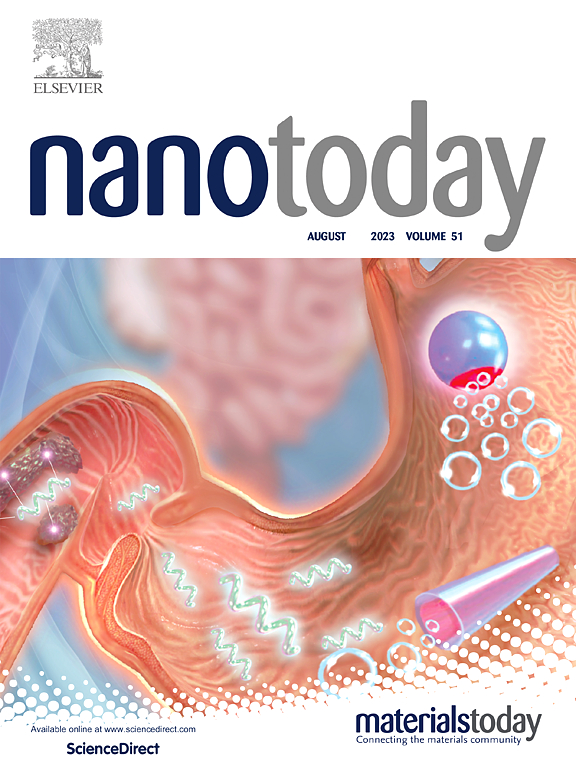Engineered nanohybrids potentiate photothermal immunotherapy of breast tumor by optimizing deep tissue penetration and controlling secondary oxidative stress
IF 13.2
1区 材料科学
Q1 CHEMISTRY, MULTIDISCIPLINARY
引用次数: 0
Abstract
Photothermal immunotherapy holds promise for tumor suppression by synergizing localized hyperthermia with systemic immune activation. However, its translation faces critical barriers, including limited penetration of photothermal agents through the dense extracellular matrix (ECM) of solid tumors and heat-triggered ROS overproduction, which exacerbates immunosuppression by disrupting immune cell functionality. These challenges are particularly acute in triple-negative breast cancer (TNBC), characterized by its aggressive progression and immunosuppressive tumor microenvironment. To overcome these limitations, we engineered a multifunctional nanohybrid integrating zinc-ion-loaded layered double hydroxide (LDH) with small-sized poly-L-DOPA (PLD) nanoparticles, further complexed with losartan. This system leverages the acidic tumor microenvironment to sequentially release Zn²⁺ and losartan, which collaboratively remodel the ECM by upregulating matrix metalloproteinase-2 (MMP-2) activity and suppressing cancer-associated fibroblast (CAF)-driven collagen deposition. The optimized ECM permeability enhances tumor accumulation of PLD, a melanin-inspired polymer that simultaneously serves as a photothermal converter and ROS scavenger. Under near-infrared irradiation, PLD generates localized hyperthermia to induce immunogenic cell death, releasing damage-associated molecular patterns (DAMPs) that activate dendritic cells and prime cytotoxic T lymphocytes. Concurrently, PLD neutralizes excess ROS, alleviating oxidative stress and restoring the effector functions of CD4⁺/CD8⁺ T cells in residual tumor niches. By dual-targeting ECM remodeling and oxidative stress modulation, this nanoplatform achieves robust tumor eradication (91.5 % suppression rate) and immune microenvironment reprogramming, offering a transformative strategy to enhance photothermal immunotherapy for TNBC and other ECM-rich malignancies.
工程纳米杂化物通过优化深层组织渗透和控制继发性氧化应激来增强乳腺肿瘤的光热免疫治疗
光热免疫疗法通过局部热疗和全身免疫激活的协同作用,有望抑制肿瘤。然而,它的翻译面临着关键的障碍,包括光热剂通过实体肿瘤致密细胞外基质(ECM)的有限渗透和热触发的ROS过度产生,这通过破坏免疫细胞功能加剧了免疫抑制。这些挑战在三阴性乳腺癌(TNBC)中尤其严重,其特点是其侵袭性进展和免疫抑制肿瘤微环境。为了克服这些限制,我们设计了一种多功能纳米杂化材料,将锌离子负载的层状双氢氧化物(LDH)与小尺寸聚左旋多巴(PLD)纳米颗粒结合,进一步与氯沙坦络合。该系统利用酸性肿瘤微环境,顺序释放Zn +和氯沙坦,通过上调基质金属蛋白酶-2 (MMP-2)活性和抑制癌症相关成纤维细胞(CAF)驱动的胶原沉积,协同重塑ECM。优化的ECM渗透性增强了PLD的肿瘤积累,PLD是一种黑色素激发的聚合物,同时作为光热转换器和ROS清除剂。在近红外照射下,PLD产生局部热疗诱导免疫原性细胞死亡,释放损伤相关分子模式(DAMPs),激活树突状细胞和主要细胞毒性T淋巴细胞。同时,PLD可以中和过量的ROS,缓解氧化应激,恢复CD4 + /CD8 + T细胞在残留肿瘤壁龛中的效应功能。通过双靶向ECM重塑和氧化应激调节,该纳米平台实现了强大的肿瘤根除(91.5 %抑制率)和免疫微环境重编程,为加强TNBC和其他富含ECM的恶性肿瘤的光热免疫治疗提供了一种变革性策略。
本文章由计算机程序翻译,如有差异,请以英文原文为准。
求助全文
约1分钟内获得全文
求助全文
来源期刊

Nano Today
工程技术-材料科学:综合
CiteScore
21.50
自引率
3.40%
发文量
305
审稿时长
40 days
期刊介绍:
Nano Today is a journal dedicated to publishing influential and innovative work in the field of nanoscience and technology. It covers a wide range of subject areas including biomaterials, materials chemistry, materials science, chemistry, bioengineering, biochemistry, genetics and molecular biology, engineering, and nanotechnology. The journal considers articles that inform readers about the latest research, breakthroughs, and topical issues in these fields. It provides comprehensive coverage through a mixture of peer-reviewed articles, research news, and information on key developments. Nano Today is abstracted and indexed in Science Citation Index, Ei Compendex, Embase, Scopus, and INSPEC.
 求助内容:
求助内容: 应助结果提醒方式:
应助结果提醒方式:


